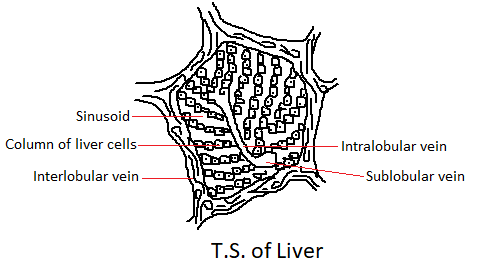
Draw a labelled histological diagram of the T.S. of the liver. Name any four of its important functions.
Answer
552.9k+ views
Hint: The liver is a dark-colored organ found in vertebrates only. It helps in the detoxification of various metabolites and produces biochemicals required for growth and digestion. It is located in the upper section of the abdomen and is wedge-shaped.
Complete answer: The liver is one of the vital organs present only in vertebrates. It is a dark reddish-brown organ having a wedge shape and is present in the upper section of the abdomen just below the diaphragm. It plays an important role in metabolism, growth, protein production, hormone production, etc. The liver is also termed as an accessory digestive organ. It produces bile which is an alkaline fluid consisting of cholesterol and bile acids. It helps in the breakdown of fats during digestion. Just under the liver lies a small pouch called the gallbladder. It helps in the storage of bile and transports it to the small intestine during digestion. The liver is made of highly specialized tissue that is made of hepatocytes. The two lobes of the liver have an unequal size and give a wedge shape to it. The blood vessels that supply the liver subdivide to form liver sinusoids. These sinusoids lead to lobules which are the functional units of the liver. Millions of hepatic cells make up these lobules.

The liver helps in detoxifying various bodily metabolites. Syntheses of various proteins and hormones necessary for digestion and growth occur in the liver. It removes toxic substances like xenobiotics and other harmful drugs.It helps in regulating the glycogen storage, production of hormones, and decomposition of red blood cells. Secretion of bile by the liver helps in the metabolism of fats.
The liver has a major role in the excretion of bilirubin. Bilirubin is a by-product of Red blood cell destruction. It is excreted along with bile. The liver is an expandable organ and thus stores large quantities of blood in its blood vessels.
Note: The liver is also involved in the storage of vitamin A, Vitamin K, iron, and vitamin D. Liver also contains many immunologically active cells. The liver also produces albumin. It is the most abundant protein found in blood serum. It has a major role in fatty acids and steroid hormone transport.
Complete answer: The liver is one of the vital organs present only in vertebrates. It is a dark reddish-brown organ having a wedge shape and is present in the upper section of the abdomen just below the diaphragm. It plays an important role in metabolism, growth, protein production, hormone production, etc. The liver is also termed as an accessory digestive organ. It produces bile which is an alkaline fluid consisting of cholesterol and bile acids. It helps in the breakdown of fats during digestion. Just under the liver lies a small pouch called the gallbladder. It helps in the storage of bile and transports it to the small intestine during digestion. The liver is made of highly specialized tissue that is made of hepatocytes. The two lobes of the liver have an unequal size and give a wedge shape to it. The blood vessels that supply the liver subdivide to form liver sinusoids. These sinusoids lead to lobules which are the functional units of the liver. Millions of hepatic cells make up these lobules.

The liver helps in detoxifying various bodily metabolites. Syntheses of various proteins and hormones necessary for digestion and growth occur in the liver. It removes toxic substances like xenobiotics and other harmful drugs.It helps in regulating the glycogen storage, production of hormones, and decomposition of red blood cells. Secretion of bile by the liver helps in the metabolism of fats.
The liver has a major role in the excretion of bilirubin. Bilirubin is a by-product of Red blood cell destruction. It is excreted along with bile. The liver is an expandable organ and thus stores large quantities of blood in its blood vessels.
Note: The liver is also involved in the storage of vitamin A, Vitamin K, iron, and vitamin D. Liver also contains many immunologically active cells. The liver also produces albumin. It is the most abundant protein found in blood serum. It has a major role in fatty acids and steroid hormone transport.
Recently Updated Pages
Why are manures considered better than fertilizers class 11 biology CBSE

Find the coordinates of the midpoint of the line segment class 11 maths CBSE

Distinguish between static friction limiting friction class 11 physics CBSE

The Chairman of the constituent Assembly was A Jawaharlal class 11 social science CBSE

The first National Commission on Labour NCL submitted class 11 social science CBSE

Number of all subshell of n + l 7 is A 4 B 5 C 6 D class 11 chemistry CBSE

Trending doubts
What is meant by exothermic and endothermic reactions class 11 chemistry CBSE

10 examples of friction in our daily life

One Metric ton is equal to kg A 10000 B 1000 C 100 class 11 physics CBSE

1 Quintal is equal to a 110 kg b 10 kg c 100kg d 1000 class 11 physics CBSE

Difference Between Prokaryotic Cells and Eukaryotic Cells

What are Quantum numbers Explain the quantum number class 11 chemistry CBSE




